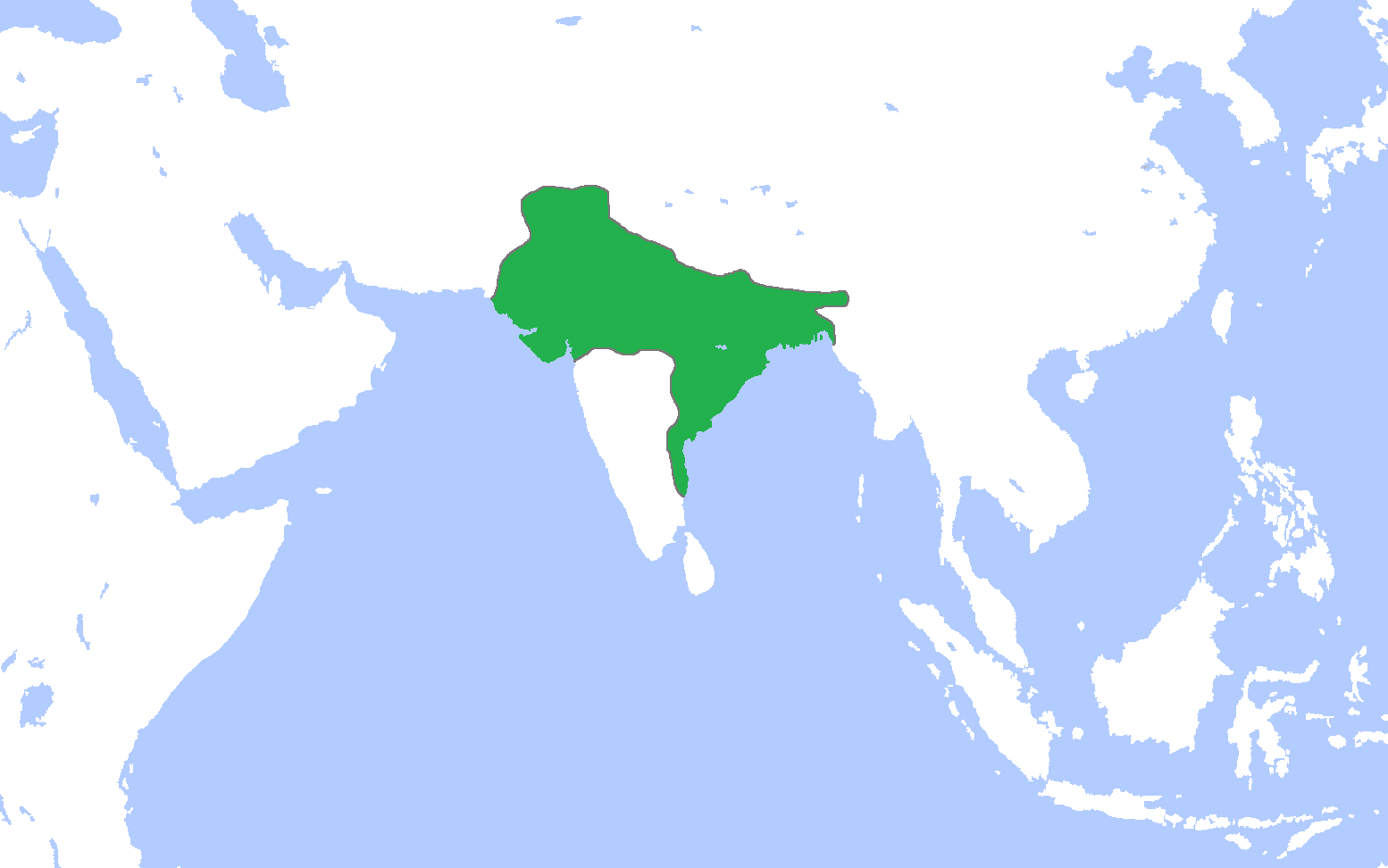More languages
More actions
(Created) Tag: Visual edit |
(Created) Tag: Visual edit |
||
| Line 2: | Line 2: | ||
{{Infobox country|name=Gupta Empire|capital=Pataliputra|mode_of_production=[[Feudalism]]|government_type=Monarchy|life_span=320–550|image_map=Gupta Empire.png|map_width=260|area_km2=3,500,000}} | {{Infobox country|name=Gupta Empire|capital=Pataliputra|mode_of_production=[[Feudalism]]|government_type=Monarchy|life_span=320–550|image_map=Gupta Empire.png|map_width=260|area_km2=3,500,000}} | ||
The '''Gupta Empire''' was a state in ancient [[India]]. | The '''Gupta Empire''' was a state in ancient [[India]]. It was the second attempt to unite India but was fragile due to a lack of centralization and quickly collapsed.<ref name=":0222" /> | ||
== History == | |||
The Gupta Empire began in the Ganges valley like the earlier [[Maurya Empire (322–184 BCE)|Maurya Empire]]. Three successive warrior-kings, [[Chandragupta]], [[Samudragupta]], and [[Chandragupta Vikramaditya]], expanded it across the northern Indian plain and then into central and southern India. The empire collapsed in the sixth century when the [[Huns]] invaded.<ref name=":0222" /> | |||
== Economy == | == Economy == | ||
The Gupta Empire was based on feudal land ownership and tribute. [[Peasantry|Peasants]] paid one-tenth to one-sixth of their harvest as taxes. | |||
[[Agriculture]] was highly organized and irrigation was widespread. India participated in a global market with Arabia, Western Asia, and [[Jin dynasty (266–420)|China]] and traded metals, gems, textiles, spices, salt, and exotic animals. [[Bank|Banks]] and money-lending were common, and guilds regulated work.<ref name=":0222">{{Citation|author=Neil Faulkner|year=2013|title=A Marxist History of the World: From Neanderthals to Neoliberals|chapter=The Medieval World|page=64–65|pdf=https://cloudflare-ipfs.com/ipfs/bafykbzacedljwr5izotdclz23o3c5p4di4t3ero3ncbfytip55slhiz4otuls?filename=Neil%20Faulkner%20-%20A%20Marxist%20History%20of%20the%20World_%20From%20Neanderthals%20to%20Neoliberals-Pluto%20Press%20%282013%29.pdf|publisher=Pluto Press|isbn=9781849648639|lg=https://libgen.rs/book/index.php?md5=91CA6C708BFE15444FE27899217FBA8E}}</ref> | [[Agriculture]] was highly organized and irrigation was widespread. India participated in a global market with Arabia, Western Asia, and [[Jin dynasty (266–420)|China]] and traded metals, gems, textiles, spices, salt, and exotic animals. [[Bank|Banks]] and money-lending were common, and guilds regulated work.<ref name=":0222">{{Citation|author=Neil Faulkner|year=2013|title=A Marxist History of the World: From Neanderthals to Neoliberals|chapter=The Medieval World|page=64–65|pdf=https://cloudflare-ipfs.com/ipfs/bafykbzacedljwr5izotdclz23o3c5p4di4t3ero3ncbfytip55slhiz4otuls?filename=Neil%20Faulkner%20-%20A%20Marxist%20History%20of%20the%20World_%20From%20Neanderthals%20to%20Neoliberals-Pluto%20Press%20%282013%29.pdf|publisher=Pluto Press|isbn=9781849648639|lg=https://libgen.rs/book/index.php?md5=91CA6C708BFE15444FE27899217FBA8E}}</ref> | ||
== Government == | == Government == | ||
Village councils and courts managed local affairs.<ref name=":0222" /> | Village councils and courts managed local affairs, and local chieftains and princes had considerable autonomy. Many officials received land in exchange for administrative work and military service.<ref name=":0222" /> | ||
== Religion == | == Religion == | ||
Latest revision as of 00:40, 17 January 2023
| Gupta Empire | |
|---|---|
| 320–550 | |
 | |
| Capital | Pataliputra |
| Dominant mode of production | Feudalism |
| Government | Monarchy |
| Area | |
• Total | 3,500,000 km² |
The Gupta Empire was a state in ancient India. It was the second attempt to unite India but was fragile due to a lack of centralization and quickly collapsed.[1]
History[edit | edit source]
The Gupta Empire began in the Ganges valley like the earlier Maurya Empire. Three successive warrior-kings, Chandragupta, Samudragupta, and Chandragupta Vikramaditya, expanded it across the northern Indian plain and then into central and southern India. The empire collapsed in the sixth century when the Huns invaded.[1]
Economy[edit | edit source]
The Gupta Empire was based on feudal land ownership and tribute. Peasants paid one-tenth to one-sixth of their harvest as taxes.
Agriculture was highly organized and irrigation was widespread. India participated in a global market with Arabia, Western Asia, and China and traded metals, gems, textiles, spices, salt, and exotic animals. Banks and money-lending were common, and guilds regulated work.[1]
Government[edit | edit source]
Village councils and courts managed local affairs, and local chieftains and princes had considerable autonomy. Many officials received land in exchange for administrative work and military service.[1]
Religion[edit | edit source]
Hinduism was the religion of the ruling class and upheld a traditional and metaphysical order based on caste and state. Buddhism applied to all classes and advocated for a moral lifestyle but was later corrupted to justify social inequality.[1]
References[edit | edit source]
- ↑ 1.0 1.1 1.2 1.3 1.4 Neil Faulkner (2013). A Marxist History of the World: From Neanderthals to Neoliberals: 'The Medieval World' (pp. 64–65). [PDF] Pluto Press. ISBN 9781849648639 [LG]
